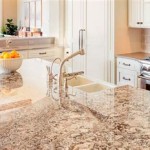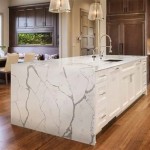Different Types of Granite for Countertops
Granite countertops have become a staple in modern kitchens and bathrooms, prized for their durability, natural beauty, and resistance to heat and scratches. Granite is an igneous rock formed deep within the earth's crust under immense pressure and heat. Its unique blend of minerals, primarily quartz, feldspar, and mica, gives each slab its distinctive color, pattern, and texture. This article explores a selection of different granite types commonly used for countertops, highlighting their characteristics and aesthetic appeal.
The variety of granite available is vast, ranging from subtle, monochromatic shades to vibrant, multi-colored compositions. Geologic processes, combined with the proportions of different minerals, contribute to the unique appearance of each granite variety. Understanding the characteristics of different granite types allows homeowners and designers to make informed choices that align with their design vision and functional requirements.
Examining Granite Color Variations and Mineral Composition
The color of granite is largely dictated by its mineral composition. The presence of quartz typically lends a white or light gray hue, while feldspar contributes pink or red tones. Darker minerals like biotite mica and amphibole result in black or dark gray shades. Variations in these minerals and the presence of other trace elements result in the wide spectrum of colors observed in granite.
White granite, sometimes referred to as "Bianco" granite, often showcases a clean and minimalist aesthetic. These granites typically consist of predominantly quartz and feldspar. Examples include Bianco Romano and White Ice. These light-colored options can brighten a space and complement a variety of cabinet colors and design styles.
Black granite, such as Absolute Black and Black Pearl, usually contains a high concentration of dark-colored minerals. Absolute Black granite is known for its uniform, almost solid black appearance, providing a bold and sophisticated look. Black Pearl granite, on the other hand, features subtle variations and shimmering flecks of mica, adding a touch of depth and texture.
Gray granite varieties are incredibly versatile and offer a neutral backdrop that can blend seamlessly with different design palettes. Examples include Silver Cloud and Luna Pearl. These granites often display intricate patterns and variations in shading, adding visual interest without being overly dominant.
Brown granite encompasses a wide range of shades, from light beige to rich chocolate brown. These stones often contain iron oxides, which contribute to their warm and earthy tones. Examples include Baltic Brown and Tan Brown. Brown granite can complement wood cabinetry and create a cozy and inviting atmosphere.
Red granite is characterized by its vibrant red hues, often caused by the presence of potassium feldspar. Examples include Red Baltic and Uba Tuba (which can sometimes appear nearly black but can have reddish undertones under specific lighting). Red granite can add a dramatic and eye-catching element to a kitchen or bathroom.
Blue granite, though less common, is a striking and luxurious option. True blue granite, where the blue color is inherent to the mineral composition, is rare. More often, the "blue" in blue granite comes from iridescence in the mineral labradorite, creating a shimmering effect. Examples include Blue Pearl and Azul Bahia, the latter being a pricier and more exclusive option.
Exploring Different Granite Patterns and Textures
Beyond color, the pattern and texture of granite play a significant role in its overall aesthetic. Granite patterns can range from fine-grained and uniform to bold and dramatic, depending on the size and distribution of the minerals.
Fine-grained granite features small, tightly packed mineral crystals, resulting in a relatively uniform appearance. These granites are often chosen for their subtle elegance and understated beauty. They are generally easier to clean and maintain due to their smoother surface.
Coarse-grained granite, on the other hand, exhibits larger, more visible mineral crystals. This creates a more textured and visually dynamic surface. The individual minerals are easily discernible, adding depth and character to the stone.
Veined granite features distinct bands or veins of color that run through the stone. These veins can be straight, curved, or swirling, creating a unique and artistic effect. Veining can add a sense of movement and sophistication to a countertop.
Granite with speckled patterns features a scattered distribution of mineral crystals, creating a mottled or speckled appearance. The size, color, and density of the speckles can vary widely, offering a range of visual effects.
Swirling patterns are characterized by fluid, undulating movements of color and texture. These patterns are often created by the folding and deformation of the rock during its formation. Swirling patterns can add a sense of drama and energy to a space.
The texture of granite can also vary depending on the finishing process. Polished granite has a smooth, glossy surface that reflects light, enhancing the colors and patterns of the stone. Honed granite has a matte finish, which provides a softer, more subtle look. Leathered granite has a textured surface that adds depth and dimension. Each finish imparts a unique feel and aesthetic to the countertop.
Analyzing the Origin and Rarity of Different Granite Types
The origin of granite can influence its price, availability, and overall characteristics. Certain granite types are quarried in specific regions around the world, each with its unique geological history and mineral composition. The rarity of a particular granite type can also contribute to its cost.
Granite from Brazil is known for its vibrant colors and intricate patterns. Brazilian granite is often used in high-end residential and commercial projects. Notable examples include Delicatus White and Golden Beach.
Granite from India is widely available and comes in a variety of colors and patterns. Indian granite is often a more affordable option compared to granite from other regions. Examples include Absolute Black and Tan Brown, which are quarried extensively in India.
Granite from Italy is renowned for its quality and elegance. Italian granite is often characterized by its subtle colors and refined patterns. Examples include Bianco Romano and Giallo Ornamental (though the latter is also quarried in Brazil).
Granite from Norway is known for its unique and striking patterns, often featuring blue or green hues. Norwegian granite is often a more expensive option due to its rarity and distinctive appearance. Blue Pearl is a well-known example.
Granite from the United States is also available, with quarries located in various states across the country. American granite is known for its durability and versatility. Examples include Dakota Mahogany and Barre Gray.
The rarity of a particular granite type can be influenced by several factors, including the size of the quarry, the demand for the stone, and the difficulty of extraction. Granite with unusual colors, patterns, or textures is often considered more rare and valuable. These factors must be considered as well in decision making for granite countertops.
In conclusion, the selection of granite for countertops offers a vast array of options, each with its own distinct characteristics and aesthetic appeal. By understanding the factors that influence color, pattern, texture, origin, and rarity, homeowners and designers can make informed choices that create beautiful and functional spaces.

Choosing The Perfect Granite Color

How To Select The Right Granite Countertops For Your Space

3 Types Of Granite Counter Tops

Easy Guide To The Diffe Granite Countertop Finishes

Types Of Granite Countertops 101 Guide 2024 Updated

What Are The Diffe Grades Of Granite Countertops Selection

Top 15 Solid Kitchen Granite Countertop Colors For 2025

Easy Nirman Construction Was Never Before Us

Types Of Granite Countertops And Colors

Top 10 High Quality Granite Colors In India
See Also








